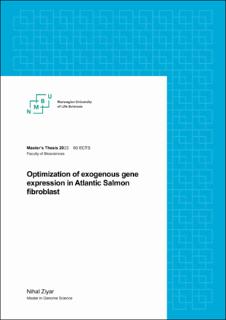| dc.contributor.advisor | Victor Boyartchuk | |
| dc.contributor.advisor | Prabin Sharma Humagain | |
| dc.contributor.author | Ziyar, Nihal | |
| dc.date.accessioned | 2023-07-15T16:28:34Z | |
| dc.date.available | 2023-07-15T16:28:34Z | |
| dc.date.issued | 2023 | |
| dc.identifier | no.nmbu:wiseflow:6839622:54592717 | |
| dc.identifier.uri | https://hdl.handle.net/11250/3079326 | |
| dc.description.abstract | Den atlanterhavslaksen er en stor del av flere økosystemer, inkludert det norske økosystemet, og er avgjørende for norsk økonomi (Aandahl & Hestvik, 2023). For å forstå dens anatomiske mekanismer og potensial for genetisk forbedring, kan genredigering i fibroblastceller utføres. Disse cellene er avledet fra organismens hud og fungerer som replikering av laksens cellulære funksjoner. Genredigeringsteknikker, som fibroblast transfeksjon for eksogen genekspresjonsundersøkelse, har for det meste blitt optimalisert for pattedyrceller så langt. Det er imidlertid mangel på informasjon om mRNA-transfeksjon hos atlanterhavslaksen. For å fylle dette gapet ble to kjemiske transfeksjonsmetoder evaluert, hvor lipofeksjon som viste seg å være mer effektivt enn kalsiumfosfat transfeksjon, noe som resulterte i ingen observerbare transfekterte celler under lysmikroskopi. I tillegg forbedret inkubering av de transfekterte cellene ved 25 °C, litt over deres typiske inkubasjonstemperatur, og supplering med gjær-tRNA forbedret transfeksjonseffektiviteten. Dettee studiet avslørte muligheten for å oppnå eksogent genuttrykk i atlantiske laksefibroblaster gjennom mRNA-transfeksjon, som er et svært viktig mål for bruk til pluripotent stamcellekultur hos atlanterhavslaksen. | |
| dc.description.abstract | The Atlantic salmon is crucial to multiple ecosystems, including the Norwegian ecosystem, and is an important driver of the Norwegian economy (Aandahl & Hestvik, 2023). To address the need for understanding its anatomical mechanisms and potential for genetic improvement, gene editing in fibroblast cells can be performed. These cells are derived from the organism's skin and serve as replication of the salmon's cellular functions. Gene editing techniques, such as fibroblast transfection for exogenous gene expression investigation, have been mostly optimized for mammalian cells so far. However, there is a lack of information regarding transient mRNA transfection in Atlantic salmon. To address this gap, two chemical transfection methods were evaluated, with lipofection proving to be more efficient than calcium phosphate transfection, which resulted in no observable transfected cells under light microscopy. Additionally, incubating the transfected cells at 25°C, slightly above their typical incubation temperature, and supplementing with yeast tRNA enhanced transfection efficiency. This study revealed the possibility of achieving exogenous gene expression in Atlantic salmon fibroblasts through mRNA transfection, which is a very important target that can be used for pluripotent stem cell culture in the Atlantic salmon. | |
| dc.language | eng | |
| dc.publisher | Norwegian University of Life Sciences | |
| dc.title | Optimization of exogenous gene expression in Atlantic Salmon fibroblast | |
| dc.type | Master thesis | |
